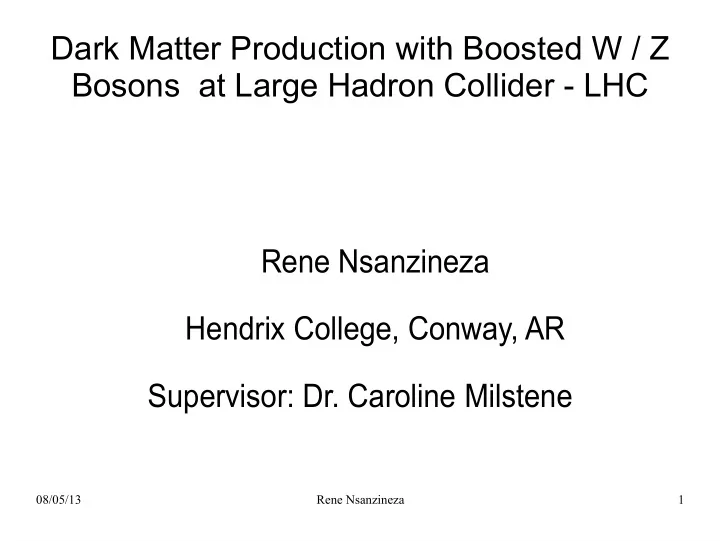

Dark Matter Production with Boosted W / Z Bosons at Large Hadron Collider - LHC Rene Nsanzineza Hendrix College, Conway, AR Supervisor: Dr. Caroline Milstene 08/05/13 Rene Nsanzineza 1
Outline ● The Large Hadron Collider (LHC) ● The Compact Muon Solenoid (CMS) detector ● Dark matter and its study at LHC ● Analysis of Monte Carlo simulations ● Results and Conclusion 08/05/13 Rene Nsanzineza 2
The Large Hadron Collider(LHC) ● World's largest particle accelerator ● Purpose:origin of mass, nature of dark matter, investigate the missing anti-matter, creation of quark-gluon plasma ● 6 detectors: ATLAS, CMS,ALICE, LHCb, TOTEM, and LHCf Fig. 1: The LHC tunnel and detectors 08/05/13 Rene Nsanzineza 3
The Compact Muon Solenoid(CMS) Dimension: 21.5m long, 15m in diameter and weighs12,500 tons. ● The point of interaction: collision location ● Fig. 2: CMS detector 08/05/13 Rene Nsanzineza 4
Dark Matter ● Components of the universe Fig. 3: Components of the Universe 08/05/13 Rene Nsanzineza 5
Evidences of dark matter existence ● Missing mass for orbital velocity of galaxies clusters measured ● Distribution of temperature of hot gases in galaxies ● Gravitational lensing of background radiation Fig.4: Gravitational Lensing 08/05/13 Rene Nsanzineza 6
Nature of Dark Matter ● Massively compact halo Objects ( MACHO's ) ? ● Weakly interacting massive particles (WIMPs ) ? Axions: neutral and less massive neutralinos : slower, massive neutrino photinos: 10-100 massive photons Fig. 6: Neutron Star Fig. 5: Black hole 08/05/13 Rene Nsanzineza 7
Dark matter study at LHC Feynman diagram for dark matter pair production Fig. 7: A Feynman Diagram of W(JJ) DM DM~ dark matter mass = 100GeV/c 2 08/05/13 Rene Nsanzineza 8
Backgrounds Reduction using MC ● Two types of cuts: kinematics & groomed jet substructure ● Particle Flow Jets: Kinematical variables → Number of jets >= 1 → Leading Jet Pt > 130 GeV/c → | η | < 1.5 → Missing Pt > 150 GeV/c ● Jet Substructure Information: → Lead jet mass in the W / Z range [65 – 105]GeV/c^2 → Variables depending on the quarks from W / Z decay 08/05/13 Rene Nsanzineza 9
Plots of the QCD Background & Signal after cuts __ bg:220.5*10 12 Events __bg: 2 504 978 Events N u __sg:112 717 Events __sg:27 907 Events m b Number of events After Kin. cuts e r o f e v e n t s Transverse momentum (GeV/c) Transverse momentum(GeV/c) Number of events __bg:5 505 Events __bg:36 960 Events Number of events __sg:10 188 Events __sg:14 229 Events After Jet sub. cuts Transverse momentum (GeV/c) Transverse momentum (GeV/c) 08/05/13 Rene Nsanzineza 10 Fig. 8: QCD Background Reduction and the Signal
Signal and Background before and after cuts signal Table 1: Signal and Backgrounds Before and After Cuts 08/05/13 Rene Nsanzineza 11
Significance Values ● Significance Table 08/05/13 Rene Nsanzineza 12
Stacked histogram of backgrounds after cuts ___ Bg_W2Jet ___ Bg_W1Jet ___ Bg_W3Jet ___ Bg_ZJNUNU400toInf ___ Bg_ZJNUNU200to400 ___ Bg_QCD170to 300 Fig. 10: Stacked Histogram of Backgrounds After Cuts 08/05/13 Rene Nsanzineza 13
Conclusion and Future Work ● Backgrounds were significantly reduced ● Good significance value ● discrepancy between the backgrounds and all data → Possible dark matter candidate ● Otherwise, in the framework of the WIMPS, we set a limit for the dark matter above 100 GeV/C^2 08/05/13 Rene Nsanzineza 14
Acknowledgement ● I would like to show my gratitude to Dr. Caroline Milstene for her patient guidance in this study. ● I also wish to acknowledge the help provided by Dr. Sudhir Malik in learning ROOT ● I owe my deepest Gratitude to Dianne Engram, Dave Paterson and the entire SIST committee for funding this project 08/05/13 Rene Nsanzineza 15
Questions ? 08/05/13 Rene Nsanzineza 16
Jets 08/05/13 Rene Nsanzineza 17
Sub-detectors of CMS(cont.) ● Sub-detectors of CMS: ● The Tracker: made in silicon pixels and silicon microstrips, → high precision momentum of charged particles. ● The Electromagnetic Calorimeter (ECAL): made of crystals of lead tungstate(PbWO4). → energy momentum of electron and photons with high precision ● Hadronic Calorimeter (HCAL): measure hadrons' energy. ● Magnet : bent the paths of charged particles ● The muon detector and the return yoke: muons. 08/05/13 Rene Nsanzineza 18
Acceleration Process at the LHC ● Linear Particle Accelerator (LINAC 2): accelerates protons up to 50 MeV. ● Proton Synchrotron Booster (PSB): protons are squeezed together and repeatedly circulated until they gain an energy of 1.4 GeV ● Proton Synchrotron (PS): protons are accelerated up to 26 GeV and they are 25 times heavier than at rest. ● Super Proton Synchrotron(SPS): protons gain energy up to 450 GeV. ● Main Ring: protons gain up to 8TeV of energy and they are 7000 times heavier than at rest 08/05/13 Rene Nsanzineza 19
Acc. Process(cont.) ● Super Proton Synchrotron(SPS):protons gain up to 450 GeV. ● Main Ring: protons gain up to 4TeV of energy and they are 7000 times heavier than at rest 08/05/13 Rene Nsanzineza 20
LHC Progress ● Discovery of the Higgs boson ● Creation of quark-gluon plasma ● New particle : bottomonium state (Xb) 08/05/13 Rene Nsanzineza 21
08/05/13 Rene Nsanzineza 22
Quantum Chromodynamics and Jets ● An extension of HCAL outside of the solenoid ● Used to detect energies of particle that went undetected through ECAL and HCAL ● Without HO → leakage in energy of particles for high P ● HO improve missing transverse energy (MET) 08/05/13 Rene Nsanzineza 23
The stacked histogram of the signal and background after cuts 08/05/13 Rene Nsanzineza 24
Why dark matter is not ordinary matter ● Theory of the big bang nucleosynthesis : 4-5 % of ordinary matter contribute to the universe ● Large astronomical searches for gravitational microlensing huge part of dark matter is not located ● Irregularities in the Cosmic microwave background (CMB) 5/6 of matter do not interact ● Current status about dark matter 08/05/13 Rene Nsanzineza 25
Recommend
More recommend